The Complete Guide to Rhinoplasty: Understanding the Procedure, Recovery, and Considerations
Rhinoplasty, commonly known as a nose job, is a surgical procedure aimed at altering the shape, size, or structure of the nose. It's a transformative procedure that requires careful consideration and understanding before making the decision to undergo surgery.
Understanding Rhinoplasty:
Cosmetic vs. Functional Rhinoplasty: Rhinoplasty can be performed for cosmetic purposes to enhance the appearance of the nose or for functional reasons to correct breathing problems or structural issues.
Consultation Process: A comprehensive consultation with a qualified plastic surgeon is crucial. During this consultation, the surgeon evaluates the patient's nasal structure, discusses desired outcomes, and explains potential risks and limitations of the procedure.
Types of Rhinoplasty:
ReductionRhinoplasty: This procedure involves reducing the size of the nose, reshaping the tip, narrowing nostrils, or correcting asymmetry to achieve better facial harmony.
Augmentation Rhinoplasty: Augmentation rhinoplasty focuses on adding volume or reshaping the nose by using implants or grafts to enhance the nasal profile.
Considerations Before Surgery:
Realistic Expectations: Understanding the limitations of the procedure and having realistic expectations regarding the final results are essential.
Health Assessment: A thorough evaluation of the patient's medical history and current health status is crucial to determine candidacy for surgery.
Discussion of Goals: Clear communication with the surgeon about specific goals and concerns helps in planning the surgical approach.
The Procedure:
Anesthesia: Rhinoplasty is typically performed under general anesthesia, ensuring the patient's comfort and unconsciousness during the surgery.
Surgical Techniques: The surgeon makes incisions either inside the nostrils (closed rhinoplasty) or across the columella (open rhinoplasty) to access and reshape the underlying nasal structures.
Recovery: Patients can expect swelling, bruising, and discomfort for several days following surgery. Nasal splints or packing may be used temporarily. Most individuals can return to work within a week, but complete recovery may take several months.
Post-Operative Care:
Follow-Up Appointments: Regular follow-up visits with the surgeon are necessary to monitor healing and remove any sutures or nasal packing.
Avoiding Strenuous Activities: Patients are advised to avoid strenuous activities and contact sports during the initial recovery phase to prevent injury to the nose.
Conclusion:
Rhinoplasty is a transformative procedure that can enhance facial harmony and self-confidence. However, it's crucial to have a clear understanding of the procedure, realistic expectations, and thorough discussions with a qualified surgeon before making the decision to undergo rhinoplasty.



Comments
Post a Comment